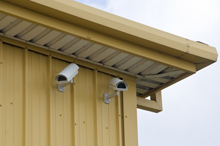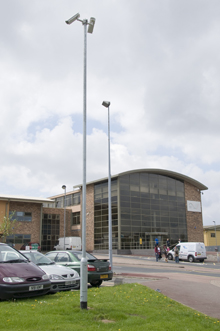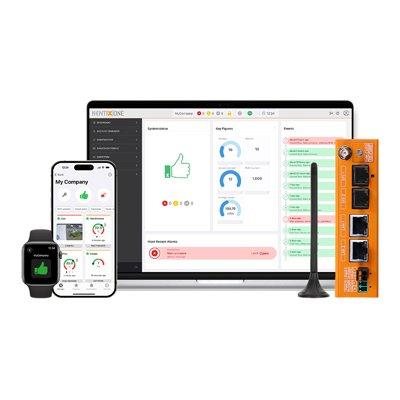 |
| Knowsley College, Liverpool |
Knowsley Community College, opened in 1984, operates across two large campuses to the northeast of Liverpool. It also has three high street ‘learning shops' and delivers courses via more than 200 community outreach centres. The college has 3,500 full-time students, largely aged between 14 and 19 years old. The vast majority of these students is located at the Kirkby and Roby campuses, which are set seven miles apart. The Kirkby campus has an award-winning vocational skills centre and offers courses such as brick laying, joinery and hair and beauty; as well as business studies, business administration and secretarial training. The college employs 700 staff including 400 teachers and has been awarded Grade One (Outstanding) in Leadership & Management by Ofsted.
Backdrop to the deployment at Kirkby campus
There had been a number of petty criminal incidents such as damaged car hubcaps and wing mirrors in the Kirkby campus' car park. It was frustrating to know that, despite investment in CCTV cameras over the years, there was no guarantee that the college's security team would be able to find the culprits or even confirm what happened following an incident. When these acts of vandalism occurred worried parents would often enquire whether the college had traced the offenders on camera. Subsequent investigations often proved unsuccessful because relevant CCTV footage could not be located and the college's principal, Sir George Sweeny, parents and staff alike were beginning to express their frustration with the situation.
This call for more effective surveillance came at a time when an interest in security in the UK was at a high and in May 2006 Sir George Sweeny tasked the college's assistant estates manager, Mr Domingo Rodriguez-Baez, with identifying and specifying a new surveillance system for both the Roby and Kirkby campuses.
Designing in 100% security at Kirkby
The Kirkby campus is surrounded by a 10-foot high spiked perimeter fence, fully controlled gates and a manned gate house. Mr Rodriguez-Baez, who is specifically responsible for security, planned the new surveillance system with 100 per cent coverage in mind. This meant integrating surveillance into every entrance, corridor, stairwell, back alley, car park, server room, boiler room and switch room. He drew up a plan of the site, excluding the Management and Industrial Innovation Centre (MIIC), which at that point was in the process of being built and was not to be included in Phase One of the install. The intention of offering complete coverage of the site was central to the planning process, as Mr Rodriguez-Baez explained:
"We wanted to ensure that if there was an incident we would be able to identify the people involved. Ideally we wanted to be able to capture the offenders on two, three or even four cameras before, during and after a crime. We wanted to have the whole picture caught on camera so I designed the system with this in mind."
Mr Rodriguez-Baez commented on the value of complete coverage of the campus: "After we installed the new system, one of our teachers reported that she had lost her bag with all her credit cards, keys and other valuables in the college's canteen. With the 100 per cent coverage offered by the new system we were able to track back to images of her leaving the canteen with the bag and walking to the staff room. We saw also that she had emerged from the staff room without the bag. It turned out it had fallen down the back of a desk while she was talking to someone, immediately before leaving the room.
Having comprehensive coverage means we can easily piece together these sorts of mysteries, avoiding unnecessary escalation of incidents. We simply could not do this kind of detective work with the old system." The college selected network video market leader Axis Communications because its range covered every conceivable requirement
With total surveillance coverage in mind, the college now had to select the most appropriate partner to work with its estates management team to install and configure the IP system specified and create the end-to-end surveillance solution around it.
Selecting the right solution and installation partner
Anixter, a leading IT distributor and provider of communications products for the security market, introduced the college to Axis, Milestone, Krone, Proxim and other leading manufacturers. Anixter also provided a short-list of three integrators and traditional security installer firms including MCW Group. All these companies were invited to submit costed proposals by 1st July 2006.
Mr Rodriguez-Baez sets the scene: "We needed support designing and installing a robust and comprehensive video storage and management solution to support the surveillance system which I had already planned out working with colleagues in the estates management team. We needed to ensure that all products we had specified fitted together easily as an end-to-end solution and as such integration skills were important. Initially I wanted to find the ideal solution so I did not set a restrictive budget upfront."
"We talked with one traditional installer who advised us to deploy a hybrid CCTV-IP solution. However, after investigating the proposed solution it became clear that it would be difficult to run third party software through it."
Mr Rodriguez-Baez also predicted that it would cost an estimated £80 per wired analogue CCTV camera to deliver the necessary 240 volts electricity. Maintenance and integration costs also looked much higher compared to an open source, networked solution that the college's in-house technical team could maintain and upgrade themselves.
In July 2006, Mr Rodriguez-Baez selected MCW Group because of the robust and fully cost-justified video storage and management solution they proposed, based on Axis network cameras, HP Proliant servers and Milestone XProtect video management software. The order for the agreed work was placed in September and installation began the following month.
CCTV versus IP-Surveillance
Having attended a seminar hosted by Anixter, Mr Rodriguez-Baez saw the merit in looking more seriously at IP-Surveillance. He explained:
"The seminar persuaded me to make a 180- degree turn in my thinking away from specifying a standalone, analogue-based CCTV system to planning for full IP-Surveillance. As far as I am concerned, analogue's lifespan is nearly over.
"Analogue-based CCTV has no future because it is not able to absorb some of the more recent technology developments such as wireless, Power over Ethernet, progressive scan, megapixel or compression enhancements including H.264. It's standing still whilst the IP equivalent is benefiting from a great many innovations all the time. I simply could not countenance going to the board of governors of the college to recommend putting in a CCTV system, which would be no less expensive, but would be obsolete within 10 years. 
Axis 232D cameras delivers DVD-quality video
"I wanted to recommend something which is future-proof. It needed to grow with our needs and enable us to make continual improvements and extensions to the system. I knew a pure IP system offered these options in a more complete way than any hybrid DVR-based or pure CCTV system. This became clearer still as I read through the recommendations of a CCTV-focused installer that had been invited to specify a new security system for us."
Axis core to system specification
Mr Rodriguez-Baez selected network video market leader Axis Communications early on for its wide range of network cameras that covered every conceivable requirement throughout the college. Mr Rodriguez-Baez explains:
"One reason I chose Axis was because it offered such a strong range of network cameras to meet all our needs both inside and out and across both campuses. Having one provider also meant it would be easier for the installer to maintain, support and integrate systems today and in the future. By restricting the camera brands we specified we were able to optimise the use of each one of them while recognising any limitations and therefore avoiding poor configuration."
Mr Rodriguez-Baez' plans called for a total of 266 Axis cameras to be deployed in Phase One of the planned deployment - 116 at the Kirkby site and 150 at Roby.
At Kirkby the installation included 81 AXIS 210A cameras with audio capability for indoor locations; 33 AXIS 221s for the internal corridors and light-variable locations; and three more AXIS 232Ds in external areas. Mr Rodriguez-Baez was also able to specify housings for all cameras and even considered robust fixing solutions to prevent cameras being ripped off the walls or the suspended ceilings by vandals.
Towards the end of the planning stage Axis launched the AXIS 212 PTZ which Mr Rodriguez-Baez decided to pilot in the Kirkby campus reception area, with great success:
"The AXIS 212 PTZ offers the holy grail in cameras as far as I'm concerned. It does the work of three high quality fixed cameras in terms of coverage, and it is extremely cost effective. I ordered a dozen almost immediately following the trial and installed four at the Kirkby site in the first phase."
This initial stage at Kirkby took place between October 2006 and February 2007. Work began with the commissioning of the servers and video management software in November; fitting out of data cabinets, as well as monitors and computers for viewing the cameras in December. January saw the fitting and termination of the Gigabit Ethernet fibre link to support rapid movement of video images. Finally, February saw the wiring up and fitting of all Axis cameras internally. Work at both Roby and Kirkby campuses was carried out in parallel. The initial system went live in April 2007 following Milestone software training of the security staff.
Phase Two - expanding into new Management and Industrial Innovation Centre (MIIC) building 
The entire survaillence system runs on a parallel network
During the spring of 2007 cabling infrastructure provider Redstone Converged Solutions deployed CAT 6 cabling throughout the new MIIC building for the IP-Surveillance system, as well as providing all the Local Area Networking (LAN) points in classrooms, as this building was near completion. Although the LAN was supported with CAT 5 cabling, Mr Rodriguez-Baez took the decision to deploy CAT 6 for all network cameras operating in this building. By using the latest cabling, future-proofing was assured, allowing for the wider deployment of megapixel cameras planned in the future.
Redstone Converged Solutions also installed a fibre link between the main building and the server rooms which are located in a separate building on the campus. Once this infrastructure was in place MCW installed an additional 57 Axis network cameras in the new building, with appropriate housings, wiring the cameras, before configuring them all correctly.
A total of 12 AXIS 212PTZs, eight AXIS 210As, 10 AXIS 221s, five AXIS 211As, 20 AXIS 207s and one AXIS 209 FD-R were deployed covering server and boiler rooms and all corridors and stairwells throughout this new state-of-the-art building.
The final system in more detail
As phase two came to a close in July 2007, Knowsley Community College had deployed a total of 324 cameras across the Kirkby and Roby campuses. At the Kirkby campus alone there are now a total of 172 Axis cameras installed: 89 210As, 41 AXIS 221s, three AXIS 232Ds and 14 AXIS 212 PTZs, 22 AXIS 207s, two AXIS 207Ws and one AXIS 209FD-R. A further 152 Axis network cameras were installed at the Roby campus, including four AXIS 212 PTZs located in this campus' restaurant and shop, all installed during the same period. Externally they have day and night functionality on all cameras and record once motion is detected, 24-hours a day.
All Axis cameras at Kirkby were linked back to a total of four HP Proliant servers which were installed in the security office at the main gate house. MCW configured these servers to handle all video surveillance data via Milestone Smart Client software and XProtect Enterprise 6.5 version recording and management software. Each server has Dual Core Xeon processors, four Gigabytes (GB) of Random Access Memory (RAM) as well as redundant power supplies and cooling fans.
These servers were then connected by SCSI controllers to two 14 Hard Disk Drive (HDD) modular storage arrays delivering 300 GB per disk. This configuration can deliver up to 12.8 Terabytes (TB) of storage across internal ‘striped' HDDs and the storage arrays, providing capacity for 28 days of images compressed at eight frames per second. A 100 Megabit per second (Mbps) Ethernet link enables rapid transfers of data to and from the storage devices.
By deploying the latest version of Milestone XProtect Enterprise, Mr Rodriguez-Baez has the option to integrate both Automatic Number Plate Recognition (ANPR) and facial recognition functionality at a later date, both of which he is considering for vetting visitors and policing assigned parking spaces.
Using Milestone's Smart Client interface it is also possible to view images from any of the Axis cameras via the security manager's mobile device if he is patrolling or is called offsite.
The entire surveillance system runs on a parallel network, using the same switch rooms but separate cabling infrastructure. Mr Rodriguez-Baez envisages fully integrating a modern IP intruder alarm, fire detection, access control, building management and even IP Telephony systems at the college. To this end it makes sense to have a dedicated parallel IP network to support these future applications, avoiding a negative impact on the performance of the data network.
 |
| Axis provided a wide range of network cameras that covered every conceivable requirement throughout the college |
Managing the system day-to-day
There are only two locations on campus where images from the cameras can be viewed: at the security gate house or in the estates director's office inside the main building. A team of three security officers is based at the gate house during the day and one security officer is on duty through the night. Visitors and students go there to report incidents and officers can then view images on six high quality LCD monitors. Visitors also need to identify themselves to security staff before obtaining access to this perimeter-secured site.
College staff visit the estates director's office to report a security event or check progress of an investigation. Both the assistant estates manager, Mr Domingo Rodriguez-Baez, and the college's estates director, Mr David Hughes, are based in this office. Mr Rodriguez-Baez views and analyses images on a bank of LCD monitors here, helping staff to track down images related to specific incidents. He is one of an estates management team of 10, headed by Mr Hughes.
As a deterrent, Mr Rodriguez-Baez also has one large monitor on display behind the reception desk which carries live video images from the AXIS 212 PTZ located in the same area to provide a view across the whole entrance hall.
"As well as providing a great fisheye view of this very large area the AXIS 212 PTZ offers a strong deterrent to those coming into the main building. Parents bringing their children in are often pleased to see this as evidence that high quality CCTV is in place. Sending a message in this way has definitely proved positive and because this is such as busy and open area there is little likelihood of wrongdoing."
Power over Ethernet creates significant savings
By investing in a 100 per cent IP solution, Knowsley College made significant savings in the install process. To have gone down the traditional CCTV route would have meant fitting fuse boxes, installing wiring and running it back to multiple electricity distribution boards. The average cost of this work equates to £80 per camera, generating a £26,000 bill, quite apart from the inherent security hazard of having a ‘fuse spare' box so close to the camera, which offers an obvious route to disabling specific cameras.
Mr Rodriguez-Baez explained: "Once I had decided to go pure IP the only vendor combination that made sense was Axis Power over Ethernet (PoE) network cameras combined with HP PoE switches and servers, all managed by Milestone XProtect and Smart Client software."
The college embraced PoE so completely that even the wireless access points provided by Proxim are PoE. The advantage of having such comprehensive cover right across the site means that Mr Rodriguez-Baez now has the tools he needs to track incidents before, during and after they occur, in order to assess what really happened.
To complete the 100 per cent coverage target, AXIS 209FD-Vs, which were originally designed for use on Stockholm's buses, are being considered for deployment in all lifts campus-wide. They offer PoE, are vandal resistant and very compact, and so are ideal for installation in these sorts of confined spaces.
Future-proofing investment
In the future the college is planning to reduce its manned guarding expenditure, which is significant given the fact that all campuses are manned around the clock. Now that it has a comprehensive IP- Surveillance system running smoothly it would be fairly easy to make the cameras available to a remote Alarm Receiving Centre (ARC). The college would only need to add two-way audio packs for the Axis cameras so that when they detect motion they send an alarm, triggering an ARC operative to verbally warn any unwanted visitors that they are being watched and should leave the site immediately. These verbal warnings can also be automated via integration with motion detection on the camera, linked also to passive infrared (PIR) systems which ensure high quality video recordings, even in the darkest conditions.
 |
| All Axis cameras are linked back to HP Proliant Servers which are installed in the security office |
Return on Investment assured
Knowsley College now has a system which has the flexibility to change and improve as its campuses expand and new technology becomes available.
Mr Rodriguez-Baez concluded: "Now that network points are in place in all classrooms I can hang a camera in minutes and link it back to a patch panel without any significant disruption or building works. Recently, someone asked if we could monitor classrooms to help optimise their usage which is becoming an issue as student numbers increase. I can install AXIS 207s in all classrooms for this purpose at relatively minimal cost and in a very short time period. These cameras could also be used for remote e-learning for example. The possibilities are endless and we now have the IP platform to provide for future requests of this kind.
"In terms of system maintenance we have been able to save more than £6,000 per month, or £72,000 per year, by using the college's in-house IT technicians rather than calling on security specialists outside. Our technical team has the IP skills at its disposal for maintaining and extending this system.
"We have spent nearly £500,000 across both sites but I know we will be talking about the savings that this initial investment has generated 10 years from now and we should see Return on Investment in less than six years. PoE has already saved us from massive electrical installation bills; going IP will save us much more in terms of ongoing maintenance. By future-proofing the system we avoid having to throw out any of this technology and can take advantage of the array of innovations now emerging from the IP-Surveillance market."




















